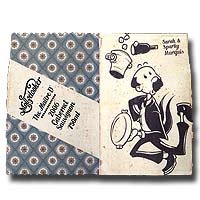
2006 Pillar Box Red (Padthaway) $13
IN BRIEF: A teeth-staining, palate-coating, spicy "fruit-bomb" that has a peculiar "savory" flavor profile that backs up a fruit-forward, pure nose. Not a flavor profile that really resonates with me. Tannins are too weak for my tastes. A well-made, super-flavorful, undeniably balanced, clean wine. Not aromatically complex.
NOSE: Shiraz ("sulfur") and Cabernet ("chocolate-candied-cherry") tones come through, with black raspberry and a hint of synthetic apple.
PALATE: Only faintly sweet. Just enough acidity that it doesn't grab attention, but frames the fruit well. Tannins are weak. This concentrated, mouth-coating wine attacks the palate with dark, savory, spicy, extracted fruit. The savory-bitter midpalate character carries through to the finish, jousting with the weak tannins long after the fruit has faded. Not viscous in the mouth, but intensely flavorful, weighty.
ASPECT: Brilliant, deep purple-red. ~2mm of clear meniscus. Completely opaque ~1cm from the edge.
COMPOSITION: Shiraz/Cab/Merlot (50/42/8). Alc 15%.
11/27/07
Previous Tasting Notes:
(Tasted at Boston Thanksgiving Dinner 11/23/07) NOSE: a little shiraz, ripe cherries, maybe more. PALATE: low acidity, slight sugar - less than Cousino Macul but more than Barrel Monkeys. Salty/savory, in the direction of rare steak. Smooth finish, low tannins. Good, unflawed finish. Fruit filled mid-palate. OVERALL: This was a good wine, not that interesting to me on the nose, not offensive. I missed the tannins. Didn't do anything exciting with the food.
Discrepancies when tasted with meal: seemed noticeably sweeter, and slightly less tannic.





